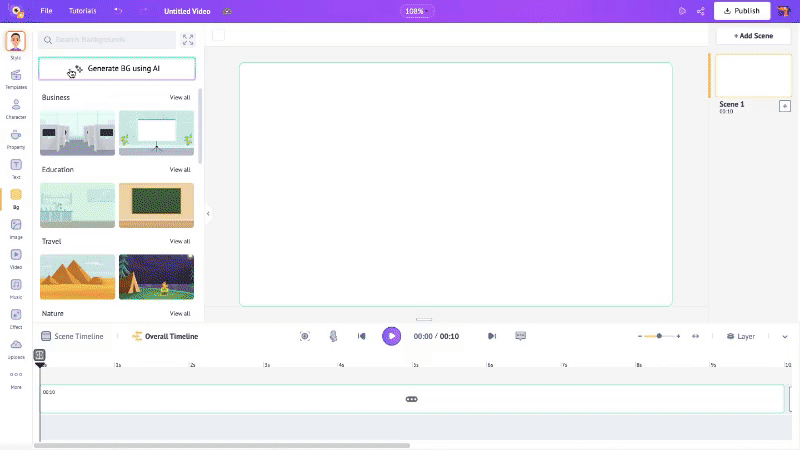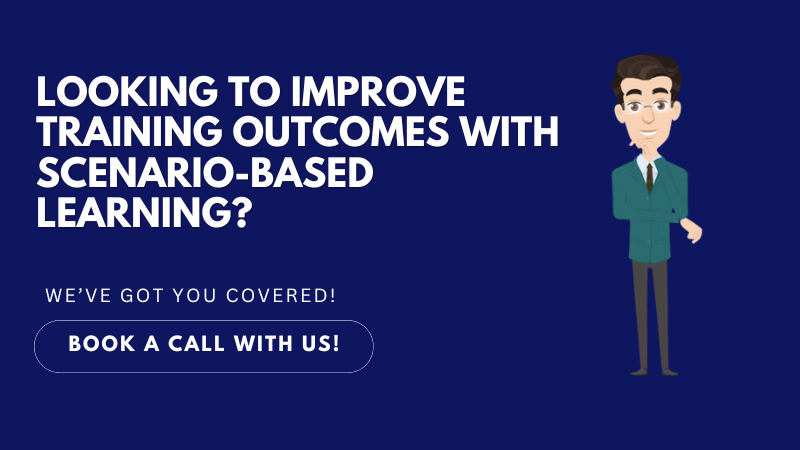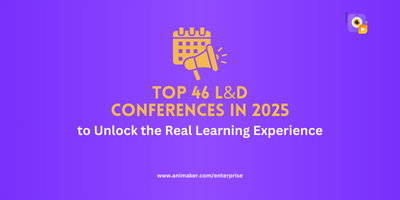Scenario Based Learning - The Next Big Thing in Corporate Training!
Is your team ready for the next big challenge?
With technology advancing every day and customer expectations constantly evolving, how can you ensure your employees are equipped to adapt quickly?
Sure, traditional learning covers the basics, but does it truly equip your team to handle the complex challenges they’ll encounter on the job?
The answer is a big NO!
So, it is time to rethink how you’re training and engage your team with a more interactive learning experience that will prepare them for real-world challenges.
Now, this is where Scenario Based Learning (SBL) can be of great help! It can bridge the gap between theory and practice, where the learners can develop their skills in a safe and controlled environment without any risk.
So, what exactly is Scenario Based Learning?
Scenario-based learning is a training strategy where learners are presented with work-related real-life situations that require them to make decisions and solve problems.
Here’s an example where Leanne, an employee, faces a choice between working overtime or setting healthy boundaries with her manager about her workload.

While traditional learning methods often focus on theoretical knowledge, scenario-based learning emphasizes practical application.
This approach helps learners develop critical thinking, problem-solving, and decision-making skills by engaging them in active learning. With that, it also lets the learners learn the consequences of their decisions.
Scenario-based learning can be delivered offline or online. Offline, it typically involves role-playing and live simulations, while online, it uses digital platforms for interactive and engaging virtual challenges.
Now that we’ve covered the basics of SBL, let's dive deeper into it in this article, where we will cover -
Let’s begin!
Different Types of Scenarios
There are several different types of scenarios that you can include in your learning. A few include:
1. Problem-Solving Scenarios
These scenarios challenge learners to identify and address specific problems or challenges. Learners are presented with a situation that requires them to diagnose the issue, analyze possible solutions, and implement the best course of action.
For example, in a customer service training module, learners might handle a difficult customer complaint and find a resolution.

This type of problem-solving scenario can be valuable for executives who must navigate complex client/stakeholder/employee interactions.
Through this type of course, they’ll learn how to handle tough situations, figure out what’s really going on, and come up with the best solution, ultimately providing better service.
2. Decision-Making Scenarios
In decision-making scenarios, learners face situations where they need to choose between several options, each leading to different outcomes.
These scenarios help learners see how their choices can shape the direction and results of a situation, showing the impact of their decisions in an engaging way.
For example, in a sales training module, learners might face a scenario where they need to decide how to handle a major client’s request for a significant discount. They could choose to offer the discount to secure the deal, negotiate for a middle ground, or decline the discount and risk losing the client.

Each decision will have different outcomes, requiring learners to carefully evaluate their options and predict the potential impact of their choices.
By the end of such scenarios, learners will feel more confident in making decisions that not only satisfy clients but also align with their business objectives.
3. Role-Playing Scenarios
In role-playing scenarios, learners step into different roles and interact with others to achieve specific goals. These scenarios are designed to develop skills such as communication, negotiation, and teamwork.
For example, in conflict resolution training, learners might engage in role-playing scenarios with their managers where they get asked questions about possible scenarios that they might face at work.

By stepping into these roles, learners practice handling difficult conversations, understanding different perspectives, and finding mutually beneficial solutions to conflicts.
By the end of such scenarios, learners will gain confidence and skills to manage difficult conversations and adopt better conflict resolution skills.
4. Simulation Scenarios
Simulation scenarios recreate real-world experiences, allowing learners to practice and refine their skills in a virtual environment. These scenarios help the learners develop practical experience and confidence in handling situations they will encounter on the job.
For example, in hospitality, learners can use simulation scenarios to practice their problem-solving skills with guests, giving them an opportunity to handle various service challenges, such as managing guest complaints and ensuring a seamless check-in process.
Hilton Hotels, the global hospitality chain, partnered with SweetRush to implement simulation training scenarios where the employees engage with one of the three digital guests who pose different problems about their stay, effectively challenging the learners to come up with solutions.

These simulation scenarios are ideal for organizations where practical experience is crucial. By the end of these scenarios, learners will gain practical experience in handling real-world challenges.
They will practice simulated interactions, building confidence in their problem-solving abilities and enhancing their decision-making skills.
These are a few types of scenarios. Next, let’s look at a few examples of scenario-based learning.
Scenario Based Learning Examples
Here, we have a couple of examples created using different tools.
1. Team etiquette
Check out the example below where Sarah, a new employee, faces challenging situations at work, and it’s up to the learners to help her navigate common workplace issues they might encounter in their own roles.
Isn’t this course engaging with its character animations?! The expressions in the characters add depth to the scenarios. (If you want to know how to create such animated scenario-based videos, then check out the link provided.)
This animated scenario-based course was created using Animaker and Articulate Storyline. Each scene in this course has an animated video created using Animaker. Its interactive elements were then added by using Articulate Storyline.
Such courses can be developed for onboarding new hires or for training existing employees who need to adapt to company culture and etiquette.
By the end of the course, the new hires will learn the do’s and don’ts while they face everyday workplace challenges, thus learning effective critical thinking skills.
Now, let’s look at another example of effective scenario-based learning.
2. Financial Hardship Awareness
Here’s an example of a course perfectly suited for financial institutions or banks that need to train customer service reps to tackle real-world challenges.
This course not only equips them with practical skills for managing customer interactions confidently but also boosts their problem-solving abilities through immersive and interactive scenarios.
The scenario-based example below features Alex, a newly hired customer service representative at a bank, navigating various customer service calls. Learners like customer service reps must guide Alex by selecting the correct response when he encounters challenging situations during these calls.
This example is integrated into the assessment section of a Rise 360 course.
This video not only stands out for its engaging animations and interactive elements, but it also provides immediate feedback to learners when they select different options, effectively encouraging them and enhancing the overall learning experience.
In contrast, an assessment created solely with Rise 360's features is typically a simple questionnaire that lacks interactive feedback.

Unlike the engaging, feedback-rich video example, these assessments don't offer the same level of encouragement or motivation for learners.
These two animated examples highlight the significant opportunities organizations have to enhance their scenario-based learning experiences.
Articulate Storyline and Rise 360 are popular eLearning authoring tools for creating interactive courses and training modules.
While those tools are great for course creation and adding interactivity, they fall short when we try to make the course content engaging and impactful. This is where Animaker shines.
If you are wondering what Animaker is, Animaker is an AI-powered video creation tool that can create professional-quality videos in minutes!

Animaker offers more advanced features than Articulate Storyline and Rise 360 for creating engaging videos. For better understanding, let’s compare the features -
1) Animated Character Library
Animaker offers diverse animated characters across various industries, making it ideal for any organization. With 1,000+ actions and 20 expressions available, you have extensive options to create customized and engaging videos.
With over 500+ characters of different ages, sizes, and professions, Animaker offers a wide range of options to ensure your videos are inclusive, relatable, and tailored to your needs.
Moreover, you can create custom characters from scratch with Animaker’s Character Builder tool, offering over a billion unique character possibilities!

In contrast, the Articulate’s characters are very limited, static, and monotonous. There is no animation option, just cutouts of characters in different poses.
So, isn’t Animaker’s character library more impressive? What’s even better is that you can create custom characters that resemble people from your organization! This way, learners can recognize characters and be more involved in the learning process.
2) Asset Library
Animaker has a rich library of 150M+ assets, from 2D backgrounds, images, and videos to royalty-free music and properties, which are all customizable!

However, the assets in Storyline are outdated and not customizable. The background options are textured and not suitable for scenario-based learning.
3) In-built AI features
Animaker has many AI features in its belt. For starters, it can generate 2D backgrounds for your videos.
For example, if you want to create scenario-based learning about customer service at a supermarket, enter relevant prompts and hit generate to get perfect 2D backgrounds for your videos!

Apart from this, you can use Animaker’s AI to generate subtitles and translate the generated subtitles into 130 languages!

Additionally, you can make use of the AI voiceover feature, which has a collection of 2000+ voices in 200+ languages for these animated characters.

The subtitles and voiceovers are automatically synced perfectly, so you don’t have to worry about manual editing.
Talk about saving time creating learning videos!
Articulate Storyline and Rise 360, on the other hand, currently lack AI features. While there are discussions about potential AI integration in the near future, it is not yet available.
From these comparisons, it's clear that Articulate Storyline and Rise 360 lacks several advanced features like 2D backgrounds, animations, lip-syncing to subtitles or voiceovers, and more.
However, one of Storyline and Rise 360’s strengths is the ability to add interactive elements essential for building scenario-based learning.
This is why combining Animaker with Articulate Storyline or Rise 360 can deliver exceptional results, blending engaging visuals with interactivity to create a truly impactful learning experience.
Now that we have seen two great examples of scenario based learning, let’s look at their benefits to understand their impact.
Benefits of Scenario Based Learning
SBL offers a range of benefits that enhance the learning experience. They are -
1. Enhanced Engagement
Scenario Based Learning boosts engagement by immersing learners in realistic and interactive situations.
Instead of just receiving information, learners actively participate in scenarios that reflect real-life challenges.
This active involvement makes the learning process more engaging and enjoyable, as learners can see the immediate impact of their actions and decisions.
2. Improved Problem-Solving Skills
Scenarios encourage learners to think critically and develop problem-solving skills by presenting complex, realistic scenarios.
Learners must assess various factors, consider potential outcomes, and choose the best option.
This approach not only enhances their problem-solving abilities but also prepares them for real-world challenges where these skills can be directly applied.
3. Safe Learning Environment
Scenario based learning offers a safe space for learners to try out different approaches and learn from their mistakes without facing real-world consequences.
This risk-free environment encourages experimentation and learning from failure, leading to a deeper understanding of concepts and better preparation for real-life situations.
4. Personalized Learning
Scenario Based Learning can be customized to fit individual or organizational needs, making it highly relevant and effective.
This personalized approach makes the learning experience more relevant and engaging and significantly enhances its effectiveness in achieving the desired outcomes.
These benefits make SBL a powerful way to prepare learners for real-world situations. Now, let’s look at a few scenario based learning examples.
***
From this article, we saw how scenario-based learning offers an engaging approach to corporate training by immersing learners in realistic scenarios that encourage problem-solving and critical thinking.
Incorporating scenario-based learning not only makes training more relevant but also prepares employees to handle real-world challenges with confidence.
Whether it’s through decision-making exercises, simulations, or role-playing, this method provides a safe environment for learners to explore different approaches, learn from mistakes, and gain practical skills.
As organizations continue to seek innovative ways to develop their teams, scenario-based learning emerges as a powerful strategy to drive meaningful learning outcomes.
By leveraging tools like Animaker and integrating various types of scenarios, corporate trainers can create impactful learning experiences that enhance engagement and effectiveness.
If you’re ready to elevate your training programs with scenario-based learning, click the banner below, and our L&D experts will be in touch to help you create amazing learning experiences for your team!









